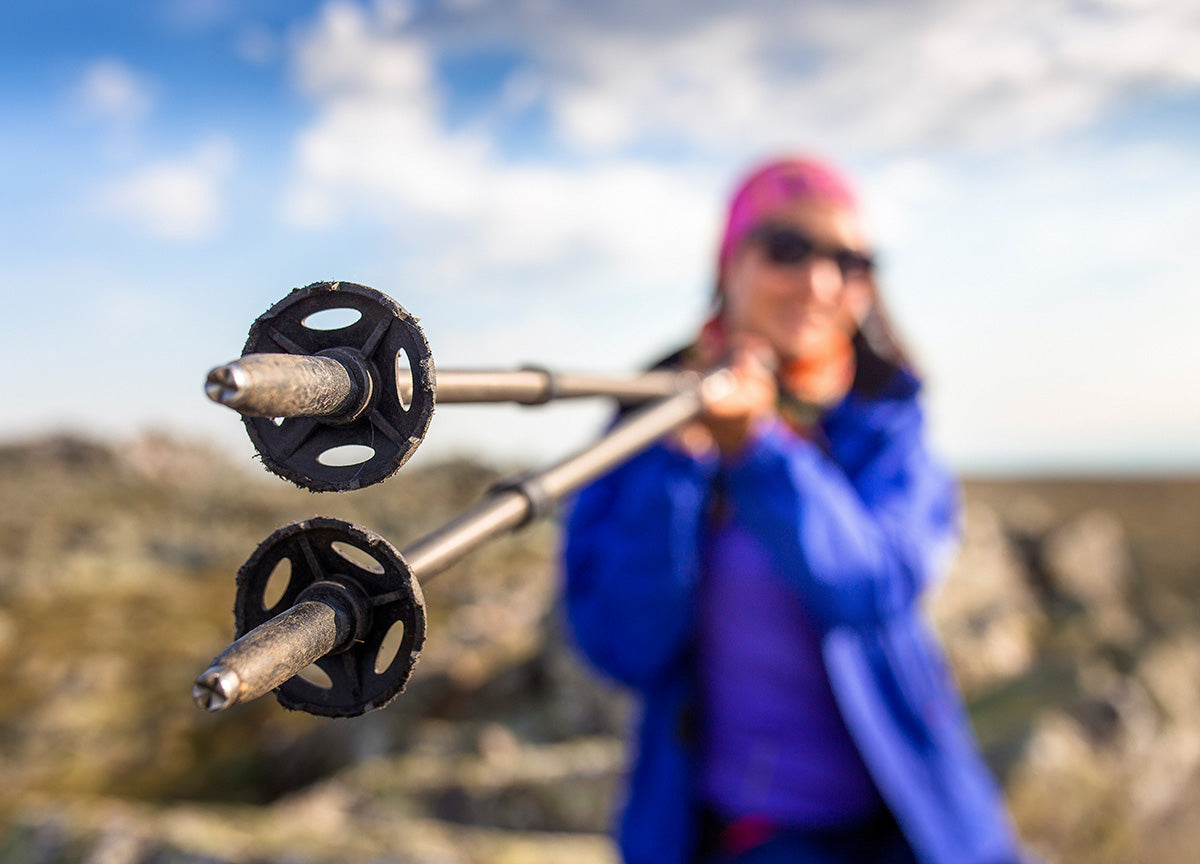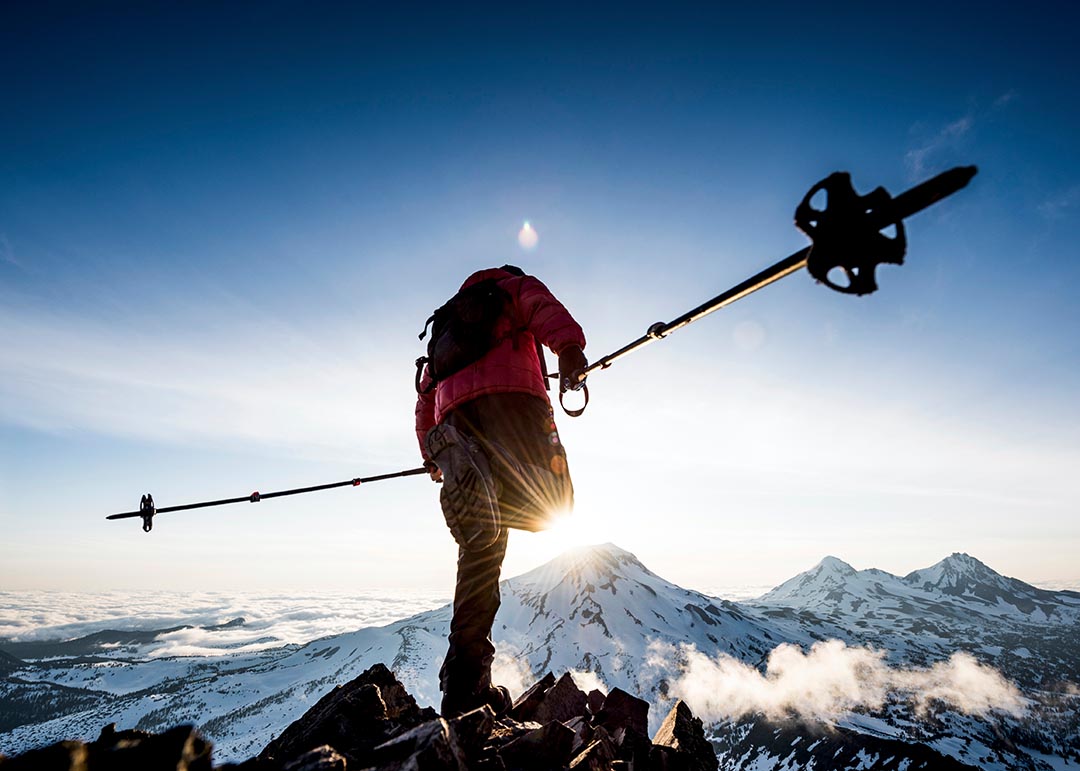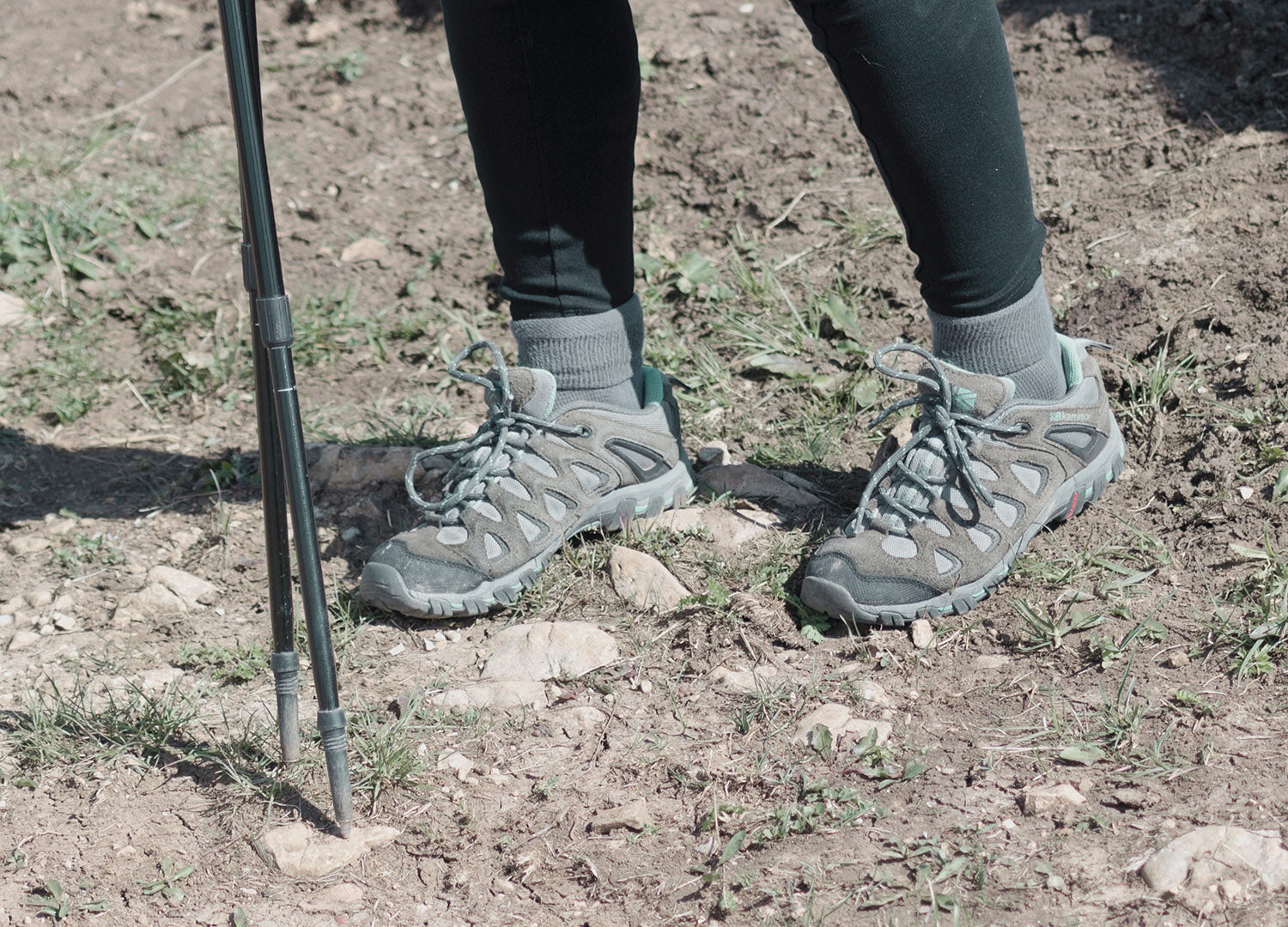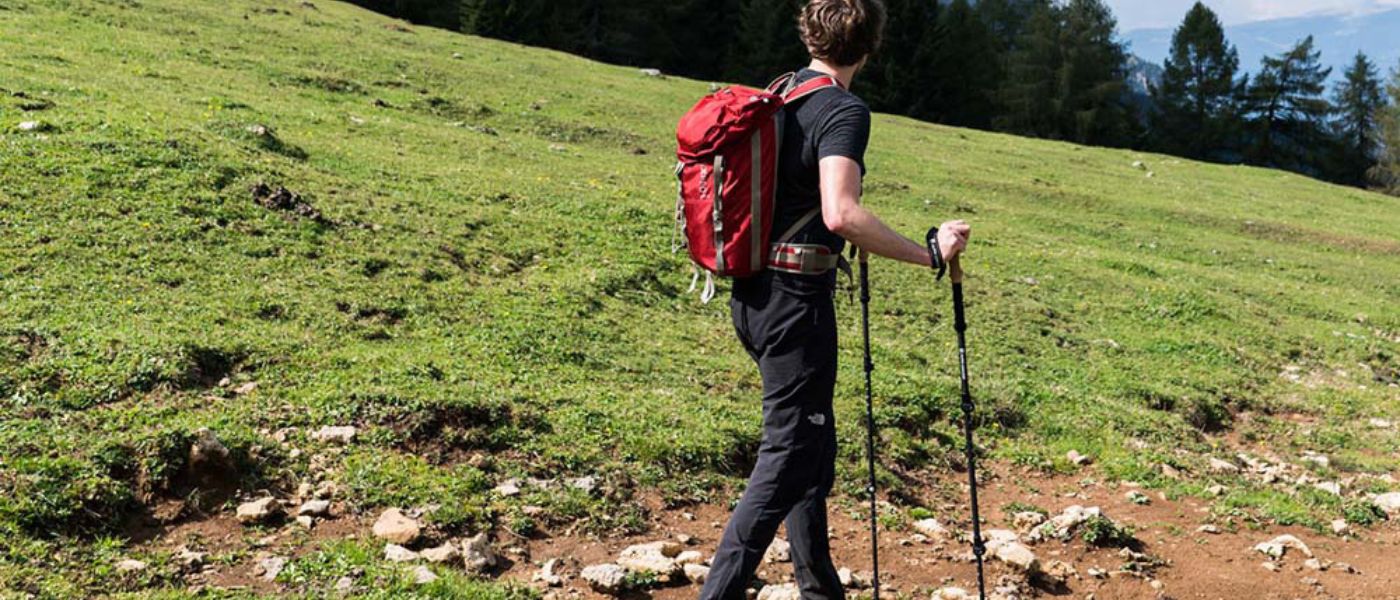Aufsätze für Wanderstöcke
Trekkingstöcke haben vier unterschiedliche Puffer für Spitzen. Welche Aufsätze für Wanderstöcke die richtigen für Dich sind, hängt vom Gelände und der Aktivität ab.
Asphalt Aufsätze
Asphalt Aufsätze werden, wie der Name schon sagt, auf sehr hartem Untergrund verwendet. Beton- bzw. Asphaltböden schaden bei dauerhaftem Gebrauch der Stockspitze. Deshalb gibt es den kleinen schwarzen Gummischuh, um die Spitze Deiner Gehhilfe zu schützen.

Es macht keinen Sinn Gummifüße für Asphalt mit Schlammteller zu kombinieren. Die Zwei Komponenten sind für völlig unterschiedliches Terrain.
Wichtig: Gummiaufsätze werden nie im Gebirge verwendet! Der Gummipuffer auf der Stockspitze verhindert einen richtigen Halt!
Nordic Walking Aufsätze
Es gibt unterschiedliche Aufsätze für Nordic Walking Stöcke. Zum einen gibt es die oben erwähnten Asphalt Aufsätze, und zum anderen gibt es Gummipuffer die Aussehen wie kleine Schuhe. Gummipuffer für Nordic Walking Aufsätze sind an der Unterseite abgerundet. Dies erleichtert das schnelle Gehen, so dass Du noch mehr Geschwindigkeit aufbauen kann.

Nordic Walking Aufsätze können für unterschiedliche Outdoor Untergründe verwendet werden: Asphalt, Wiese, Kiesweg und Waldboden, wenn er nicht zu weich ist.
Schlamm Aufsätze
Schlammteller verhindern das Einsinken in Sand, Erde oder in den Matsch. Zusätzlich ist der Schlammaufsatz eine Hilfe für die Stockspitze, damit sie nicht zu tief in Geröll einsinken kann, oder in kleine Spalten rutscht und somit eingeklemmt werden könnte. Schlamm Aufsätze für Wanderstöcke haben ein Drehgewinde und werden auf die Stockspitze aufgeschraubt.

Matschteller Aufsätze für Wanderstöcke haben einen kleineren Durchmesser wie Schneeteller.
Schnee Aufsätze
Schneeteller sind eigens für die kalte Jahreszeit gemacht. Dieser Stockaufsatz für den Winter, kann nicht nur für Spaziergänge im Schnee verwendet werden, sondern auch für das Schneeschuh-Wandern.
Vor allem im Winter werden Schneeteller für das Touren Gehen verwendet. Egal ob Skifahrer*in oder Snowboardfahrer*in, werden Dir Wanderstöcke mit Schneeteller, den Aufstieg maßgeblich erleichtern. Wenn Du Snowboarder*in bist, und Du deine Stöcke nicht für die Abfahrt verwendest, raten wir Dir zu leichten faltbaren Trekkingstöcken, die während der Abfahrt im Rucksack verstaut werden können.

Schneeteller werden wie die Schlammteller auf die Stockspitze aufgeschraubt.
Aufsatz Verwendung ohne Gummipuffer
Keine Aufsätze solltest Du immer dann verwenden, wenn Du auf weichen Untergründen gehst. Dies ist bspw. der Waldboden oder im Schnee.
Hier brauchst Du keine extra Pads, da das Eindringen der Spitze deutlich mehr Halt gibt. Bei zu Weichen Böden, greifst Du wieder auf die Teller zurück, damit deine Stockspitzen nicht stecken bleiben. Bei Pulverschnee in den Du einsinken kannst, würdest Du bspw. wieder auf Telleraufsätze zurückgreifen.

In diesem eher trockenen Terrain werden Wanderstöcke ohne Aufsatz verwendet. Die Spitze bietet genug halt. Die Wanderstöcke können nicht einsinken, und brauchen deshalb auch keinen Schlammaufsatz.
Ähnliche Blog Beiträge
Using hiking poles correctly: This is how hiking poles really make a difference
Trekking poles are not just for older people. Hikers of all ages benefit from using poles. With the right walking technique, they can best support your legwork and sense of balance. Additionally, trekking poles contribute to joint protection.
However, there are a few points to consider when using them, which we will show you in the following blog post.
When should you use trekking poles?
Trekking poles are a valuable companion on every hike. Especially when ascending and descending, using poles is worthwhile. They reduce your exertion and the strain on
- muscles,
- tendons
- and joints.
But even in rough terrain, you are always ahead with trekking poles. Especially on slippery, rocky, or muddy terrain, they offer you optimal support and prevent slipping.
Are you more of a video type? No problem, in our buying guide we go into detail on the topic
Video Consultation Trekking Poles » How to Find the Right Trekking Poles
What are the benefits of using trekking poles?
Experienced and sure-footed hikers can relieve their knees and improve balance with poles in certain areas. However, the body should often have the opportunity to move freely (without poles) to train the sense of balance.
When the telescopic trekking poles are not in use, they should rest loosely in the hand and be held in the middle. This way, they do not get in the way.
Can you use trekking poles for hiking in the snow?
Yes! Our telescopic and folding poles come with various attachments. The so-called snow baskets are primarily designed for use in the snow. So nothing stands in the way of a winter snow hike. Even in the other seasons, trekking poles can provide you with good service. The attachments can be swapped in no time and offer you the right grip in any weather and on any surface:
- Snow baskets are optimal for snow hiking.
- Asphalt tips are suitable for use on hard surfaces.
- Poles without rubber buffers have proven themselves on dry mountain terrain. (In a lot of scree, you can additionally use the mud attachments to prevent sinking.
- Mud inserts are ideal for sand, earth, and mud.
- Nordic walking tips make it easier to walk quickly on firm ground.
Proper hiking with poles: These techniques exist
As is well known, there are many ways to reach a goal. This also applies to hiking pole techniques. The following three techniques are used:
1. The Diagonal Technique:
This technique is used in moderate terrain. This includes mostly flat routes with a slight incline.
- As you are used to when walking, arms and legs are moved in opposite directions.
- If your left leg is forward, the right pole is used at the same time – and vice versa.
You can apply this diagonal technique quite intuitively.

2. The Double Pole Technique:
With the double pole technique, you are well equipped for steep terrain.
- Both poles are placed clearly in front of the body and feet.
- Then you walk through them in two to four steps.
- On steep cross paths, it is advantageous to hold the poles at different heights: mountain side below the grip – valley side you can support yourself on the knob.
3. The Side Support Method:
This method is used in extremely steep terrain.
- Here you need to grasp one or both poles.
- In doing so, you grip the pole with the mountain-side hand near the tip and with the valley-side hand about two-thirds of the length or at the grips.
- Then you place the tip in front of the body (side and about hip height) into the slope.
- The mountain-side arm is stretched and the body supports itself on this side, the other hand presses the poles against the slope.
- You take two steps, then repeat the process.
Expert Tip: When descending, you only achieve knee relief with the poles if you place them parallel in front of the body. You bring the upper body forward and the legs are bent to then set the poles far forward and down.
This pole use is done only every two to three steps. In steep descents, the hiking poles need to be set slightly longer.
When should trekking poles not be used?
In rock terrain prone to falls, the poles should be in the outdoor backpack be. They absolutely do not belong on the wrists. If you attach trekking poles to the outside of your backpack, make sure they are properly secured. Otherwise, they can become an obstacle.
Pole Loops
The loops of the trekking poles should really only be used on completely flat terrain. If your hands are in the pole loops and you stumble, you are otherwise "tied up" and cannot hold on or support yourself.
Conclusion
When trekking poles are used correctly, they are a valuable support on every tour. Even though the diagonal technique requires no prior knowledge and is applied intuitively, it should not be used in all terrains. Especially in steep terrain, you should rather opt for the double pole use or the side support method.
FAQ
Can I use trekking poles on steep descents?
Yes, of course you can use trekking poles downhill. Even on steep descents, trekking poles are helpful equipment. Here, it's best to use the side support method as described above.
Use one or two trekking poles?
Whether you use one or two trekking poles is up to you. For longer hikes and with the corresponding luggage, it is advisable to use two poles based on experience. However, for shorter excursions on flatter terrain, you can also easily go with one trekking pole.
How do I store my trekking poles when I'm not using them?
If you don't need your trekking poles, they are best stored in the backpack. Telescopic poles can be collapsed with just a few movements.
Foldable trekking poles can be folded in no time. Thanks to their small pack size and weight, both models fit into any hiking backpack.
Do you want to know more about trekking poles? Read on here:




